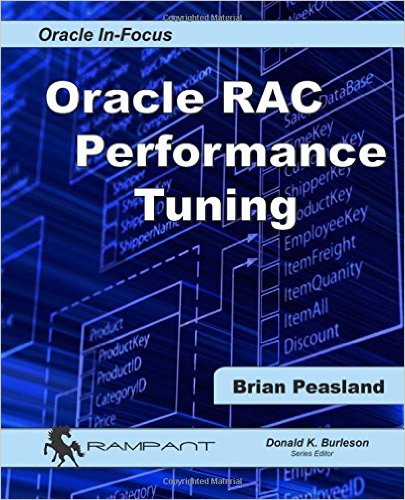Some time ago, I received a free review copy of Brian Peasland‘s recent book, Oracle RAC Performance Tuning.
First, a note on my RAC background: I spent 7 years on Oracle’s RAC Support team. When customers had an intractable RAC performance issue, I was on the other end of the “HELP!” line until it was resolved.
I made Brian’s acquaintance through the MOS RAC Support forum, where Brian stood out as a frequent poster who consistently gave well-thought-out, correct and informative responses. So I had high expectations when I sat down with his book. And I haven’t been disappointed. This book is a terrific resource for single-instance DBAs looking to come up to speed on RAC. It’ll also be useful to more experienced RAC DBAs who want to deepen their knowledge or who just have a thorny performance problem to solve.
Many RAC books start out with an overview of RAC-specific physical architecture: the interconnect and the shared storage. Not this one. Brian leaps straight into what I consider the “hard” stuff: chapter 2 covers Cache Fusion and understanding RAC-specific wait events. I’ve spoken with many RAC DBAs who’d have a hard time telling me the difference between “gc cr block 2-way” and “gc current grant 3-way”. You really need to understand Oracle’s implementation of Cache Fusion to understand many of the RAC wait events, and Chapter 2 does a good job of explaining, using session tracing to step you through the waits. It might seem odd to start out with detailed explanations of wait events that many RAC DBAs will never see in the Top 10. But, a good understanding of Cache Fusion and the related wait events is really necessary to understand RAC-specific slowdowns. Subsequent chapters depend implicitly on this understanding: you can’t really understand interconnect tuning, for instance, unless you understand how the interconnect is used by Cache Fusion.
The book covers a full toolkit of testing utilities and tools as needed: Orion is introduced in the chapter on storage, and then a full chapter is devoted to the RAC Support Tools, another to AWR/ADDM/ASH, and another to benchmark utilities. There are also dozens of SQL scripts.
Another chapter to highlight is Chapter 14, a two-page summary at the end of the book that lists what Brian considers the central points. This is a mix of broad principles and RAC-specific “gotchas” that every RAC DBA should be aware of. I’d say that if you can read through Chapter 14 and say “I knew that” to each point, then you’ve got a good grasp of the essentials of RAC tuning.
Like others I’ve read in Burleson’s Oracle In-Focus series, this book would’ve benefited from a stronger copy editor. I was chagrined to see typos right on the back cover. But that’s a small quibble that doesn’t detract from an excellent book. If you’re a RAC DBA, this book deserves a place on your bookshelf.
